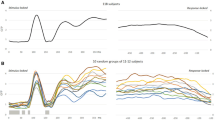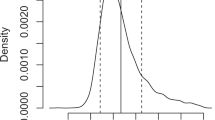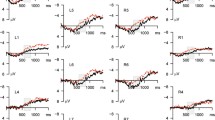Abstract
Behavioral and neuropsychological studies on written production suggested that some cognitive processes are common with spoken production. In this study, we attempted to specify the time course of common processes between the two modalities with event-related brain potentials (ERPs). High density EEG was recorded on twenty two healthy participants during a handwritten and an oral picture naming task on the same 120 stimuli. Waveform analyses and topographical pattern analyses were combined on stimulus- and response-aligned ERPs in order to cover the whole word encoding processing. Similar electrophysiological correlates between writing and speaking appeared until about 260 ms. According to previous estimations of the time course of spoken production, the time period of identical electrophysiological activity corresponds to visual (0–150 ms) semantic (150–190 ms) and lexical-semantic (190–275 ms) processes. Then, spoken and handwritten picture naming starts diverging and display different and modality specific topographical configurations from around 260 ms, i.e., at the beginning of the time-window associated to the encoding of the surface phonological form in spoken production. These results suggested shared conceptual and lexical-semantic processes between speaking and writing and different neurophysiological activity during word-form (phonological or orthographic) encoding.


Similar content being viewed by others
Notes
Baseline correction was not applied for the following reasons. First, it is difficult to establish a good time window to be used as baseline for both stimulus- and response-aligned data. One can imagine using a pre-stimulus period. Nevertheless, we cannot exclude different recruitment of preparatory neural resources across conditions, specially because the sentence “lift the pen” appeared on the screen before the ready signal in the handwritten condition, which may induce differences in the pre-stimulus period across conditions. A discussion of possible consequences of pre-stimulus baseline correction on ERPs when different tasks are compared can be found in Michel et al. (2009, p. 43).
References
Alario FX, Ferrand L (1999) A set of 400 pictures standardized for French: Norms for name agreement, image agreement, familiarity, visual complexity, image variability, and age of acquisition. Behav Res Methods Instrum Comput 31:531–552
Baayen RH, Davidson DJ, Bates DM (2008) Mixed-effects modeling with crossed random effects for subjects and items. J Mem Lang 59:390–412
Badecker W (1996) Representational proprieties common to phonological and orthographic output systems. Lingua 99:55–83
Basso A, Taborelli A, Vignolo LA (1978) Dissociated disorders of speaking and writing in aphasia. J Neurol Neurosurg Psychiatry 41:556–563
Bates DM, Sarkar D (2007) Lmer4: linear mixed-effects models using S4 classes. R package version 0.99875-6
Baxter DM, Warrington EL (1986) Ideational agraphia: a single case study. J Neurol Neurosurg Psychiatry 49:369–374
Boersma P, Weenik D. 2007. Praat: doing phonetics by computer. Institute of Phonetic Sciences of the University of Amsterdam. http://www.praat.org
Bonin P, Fayol M, Gombert J-E (1998) An experimental study of lexical access in the writing and naming of isolated words. Int J Psychol 33:269–286
Bonin P, Peereman R, Fayol M (2001) Do phonological codes constrain the selection of orthographic codes in written picture naming? J Mem Lang 45:688–720
Bonin P, Chalard M, Méot A, Fayol M (2002) The determinants of spoken and written picture naming latencies. Br J Psychol 93:89–114
Bonin P, Peereman R, Malardier N, Méot A, Chalard M (2003) A new set of 299 pictures for psycholinguistic studies: French norms for name agreement, image agreement, conceptual familiarity, visual complexity, image variability, age of acquisition and naming latencies. Behav Res Methods Instrum Comput 35:158–167
Britz J, Landis T, Michel CM (2009) Right parietal brain activity precedes perceptual alternation of bistable stimuli. Cereb Cortex 19:55–65
Brownsett SIE, Wise RJS (2010) The contribution of the parietal lobes to speaking and writing. Cereb Cortex 20:517–523
Brunet D, Murray MM, Michel CM (2011) Spatiotemporal analysis of multichannel EEG: CARTOOL. Comput Intell Neurosci. doi:10.1155/2011/813870
Camen C, Morand S, Laganaro M (2010) Re-evaluating the time course of gender and phonological encoding during silent monitoring tasks estimated by ERP: serial or parallel processing? J Psycholinguist Res 39:35–49
Caramazza A (1997) How many levels of processing are there in lexical access? Cogn Neuropsychol 14:177–208
Caramazza A, Miceli G (1990) The structure of graphemic representations. Cognition 37:243–297
Cornelissen K, Laine M, Tarkiainen A, Jarvensivu T, Martin N, Salmelin R (2003) Adult brain plasticity elicited by anomia treatment. J Cogn Neurosci 15:444–461
Dell GS (1986) A spreading-activation theory of retrieval in sentence production. Psychol Rev 93:283–321
Eulitz C, Hauk O, Cohen R (2000) Electroencephalographic activity over temporal brain areas during phonological encoding in picture naming. Clin Neurophysiol 111:2088–2097
Forbes KE, Vinneri A (2003) A case for case: handling letter case selection in written spelling. Neuropsychologia 41:16–24
Hauk O, Rockstroh B, Eulitz C (2001) Grapheme monitoring in picture naming: an electrophysiological study of language production. Brain Topogr 14:3–13
Henry ML, Beeson PM, Stark AJ, Rapcsak SZ (2007) The role of left perisylvian cortical regions in spelling. Brain Lang 100:44–52
Indefrey P, Levelt WJM (2004) The spatial and temporal signatures of word production components. Cognition 92:101–144
Jaeger TF (2008) Categorical data analysis: away from ANOVAs (transformation or not) and towards logit mixed models. J Mem Lang 59:434–446
Jescheniak JD, Schriefers H, Garrett MF, Friederici AD (2002) Exploring the activation of semantic and phonological codes during speech planning with event-related brain potentials. J Cogn Neurosci 14:951–964
Jescheniak JD, Hahne A, Schriefers H (2003) Information flow in the mental lexicon during speech planning: evidence from event-related brain potentials. Cogn Brain Res 15:261–276
Katanoda K, Yoshikawa K, Sugishita M (2001) A functional MRI study on the neural substrates for writing. Hum Brain Mapp 13:34–42
Koester D, Schiller NO (2008) Morphological priming in overt language production: electrophysiological evidence from Dutch. Neuroimage 42:1622–1630
Laganaro M, Perret C (2011) Comparing electrophysiological correlates of word production in immediate and delayed naming through the analysis of word age of acquisition effects. Brain Topogr 24:19–29
Laganaro M, Morand S, Schnider A (2009) Time course of evoked-potential changes in different forms of anomia in aphasia. J Cogn Neurosci 21:1499–1510
Lehmann D, Skrandies W (1984) Spatial analysis of evoked potentials in man—a review. Prog Neurobiol 23:227–250
Levelt WJM (1989) Speaking: from intention to articulation. The MIT Press, Cambridge
Levelt WJM, Roelofs A, Meyer AS (1999) A theory of lexical access in speech production. Behav Brain Sci 22:1–75
Lubrano V, Roux FE, Démonet JF (2004) Writing-specific sites in frontal areas: a cortical stimulation study. J Neurosurg 101:793–804
Maess B, Friederici AD, Damian M, Meyer AS, Levelt WJM (2002) Semantic category interference in overt picture naming: an Meg study. J Cogn Neurosci 14:455–462
McCloskey M, Badecker W, Goodman-Schulman RA, Aliminosa D (1994) The structure of graphemic representations in spelling: evidence from a case of acquired dysgraphia. Cogn Neuropsychol 11:341–392
Michel CM, Thut G, Morand S, Khateb A, Pegna AJ, Grave de Peralta R (2001) Electric source imaging of human brain functions. Brain Res Rev 36:108–118
Michel CM, Murray MM, Lantz G, Gonzalez S, Spinelli L, Grave de Peralta R (2004) EEG source imaging. Clin Neurophysiol 115:2195–2222
Michel CM, Koenig T, Brandeis D, Gianotti LRR (2009) Electric neuroimaging. Cambridge University Press, Cambridge
Murray MM, Camen C, Gonzalez ASL, Bovet P, Clarke S (2006) Rapid brain discrimination of sounds of objects. J Neurosci 26:1293–1302
Murray MM, Brunet D, Michel CM (2008) Topographic ERP analyses: a step-by-step tutorial review. Brain Topogr 20:249–264
Oldfield RC (1971) The assessment and analysis of handedness: the Edinburgh inventory. Neuropsychologia 9:97–113
Pascual-Marqui RD, Michel CM, Lehmann D (1995) Segmentation of brain electrical activity into microstates: model estimation and validation. IEEE Trans Biomed Eng 42:658–665
Perret C. Laganaro submitted. Why are written naming latencies (not) longer than spoken naming?
Rapcsak SZ, Beeson PM (2002) Neuroanatomical correlates of spelling and writing. In: Hillis AE (ed) Handbook on adult language disorders: integrating cognitive neuropsychology, neurology, and rehabilitation. Psychology Press, Philadelphia, pp 71–99
R-development core team (2007) R: a language and environment for statistical computing. R Foundation of Statistical Computing, Vienna. http://www.R-project.org
Riès S, Janssen N, Dufau S, Alario FX, Burle B (2011) General-purpose monitoring during speech production. J Cogn Neurosci 23:1419–1436
Rodriguez-Fornells A, Schmitt BM, Kutas M, Münte TF (2002) Electrophysiological estimates of the time course of semantic and phonological encoding during listening and naming. Neuropsychologia 40:778–787
Roeltgen D, Heilman KM (1984) Lexical agraphia: further support for the two-system hypothesis of linguistic agraphia. Brain 107:811–827
Roux FE, Dufor O, Giussani C, Wamain Y, Draper L, Langcamp M, Démonet JF (2009) The graphemic/motor frontal area exner’s area revisited. Ann Neurol 66:537–545
Schnider A, Mohr C, Morand S, Michel CM (2007) Early cortical response to behaviorally relevant absence of anticipated outcomes: a human event-related potential study. Neuroimage 35:1348–1355
Strijkers K, Costa A, Thierry G (2010) Tracking lexical access in speech production: Electrophysiological correlates of word frequency and cognate effects. Cereb Cortex 20:912–928
Sugihara G, Kaminaga T, Sugishita M (2006) Interindividual uniformity and variety of the “writing center”: a functional MRI study. Neuroimage 32:1837–1849
Van Galen GP (1991) Handwriting: issues for a psychomotor theory. Hum Mov Sci 10:165–191
Van Turennout M, Hagoort P, Brown CM (1998) Brain activity during speaking: from syntax to phonology in 40 milliseconds. Science 280:572–574
Van Turennout M, Hagoort P, Brown CM (1999) The time course of grammatical and phonological processing during speaking: evidence from event-related brain potentials. J Psycholinguist Res 28:649–676
Vihla M, Laine SM, Salmelin R (2006) Cortical dynamics of visual/semantic vs. phonological analysis in picture naming. Neuroimage 33:732–738
Zhang Q, Damian MF (2009) The time course of segment and tone encoding in Chinese spoken production: an event-related potential study. Neuroscience 163:252–265
Acknowledgments
This research was supported by Swiss National Science Foundation grant no. PP001-118969/1. The Cartool software (http://brainmapping.unige.ch/Cartool.php) has been programmed by Denis Brunet, from the Functional Brain Mapping Laboratory, Geneva, Switzerland, and is supported by the Center for Biomedical Imaging (CIBM) of Geneva and Lausanne. The authors wish to thank two anonymous reviewers for very helpful comments on a previous version of this paper.
Author information
Authors and Affiliations
Corresponding author
Rights and permissions
About this article
Cite this article
Perret, C., Laganaro, M. Comparison of Electrophysiological Correlates of Writing and Speaking: A Topographic ERP Analysis. Brain Topogr 25, 64–72 (2012). https://doi.org/10.1007/s10548-011-0200-3
Received:
Accepted:
Published:
Issue Date:
DOI: https://doi.org/10.1007/s10548-011-0200-3




